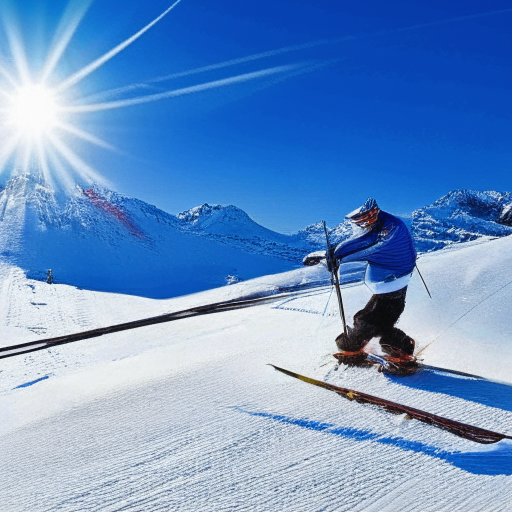Enhance Your Eye Safety: In-Depth Insights on Snow Blindness and How to Prevent It
As the enchanting winter season blankets the world in a stunning display of white, it is crucial to understand the potential risks associated with outdoor activities in these beautiful yet hazardous snowy environments. One of the most serious concerns is snow blindness, a painful condition that occurs due to prolonged exposure to ultraviolet (UV) rays reflected off snow. This comprehensive article delves into the complex science of snow blindness, examines the effects of sunlight on snow-covered landscapes, and offers practical strategies for preventing, diagnosing, and treating this condition effectively. By understanding the root causes and implementing protective measures, we can enjoy the splendor of winter while safeguarding our precious eye health.

Unpacking the Medical Definition and Root Causes of Snow Blindness
The clinical term for snow blindness is photokeratitis, which describes a temporary injury to the cornea, the eye’s outermost protective layer. This distressing condition primarily arises from excessive exposure to high levels of ultraviolet (UV) radiation, especially those rays that bounce off snow-covered surfaces. The intense sunlight, particularly in high-altitude environments where the atmosphere is thinner, can lead to significant eye discomfort and, in some cases, lasting vision problems. While snow blindness is typically self-limiting and resolves within a short time, understanding its underlying causes is essential for implementing effective prevention and management strategies to protect your vision.
Understanding the Impact of Sunlight on Snowy Environments and Eye Health
To fully grasp the dynamics of snow blindness, it is important to explore how sunlight interacts with the surface of the snow. Sunlight travels through the atmosphere and includes a range of wavelengths, some of which can be harmful, such as ultraviolet (UV) radiation. When these rays strike a snow-covered terrain, the unique reflective properties of snow can bounce back as much as 80% of these UV wavelengths, significantly increasing exposure levels. This reflective effect is particularly pronounced in high-altitude areas where the atmosphere’s ability to filter UV radiation is reduced. Consequently, the eyes can easily become overwhelmed by excessive UV exposure, resulting in potential damage to the cornea, conjunctiva, and other vital eye structures.
Recognizing the Symptoms of Snow Blindness for Timely Intervention
The signs of snow blindness typically manifest several hours after intense UV exposure. While the severity of symptoms can differ from person to person, common indications include:
Eye discomfort and pain: Many people experience a gritty feeling or the sensation of having foreign objects in their eyes.
Redness and swelling: The eyes may appear bloodshot, and eyelids can swell and show signs of inflammation.
Watery eyes: Increased tearing occurs as the eyes attempt to flush out irritants and alleviate discomfort.
Blurry vision: Clear vision can be challenging, complicating activities like reading or driving due to visual distortion.
Sensitivity to light: Known as photophobia, heightened light sensitivity often comes with headaches.
Sensation of halos: Some individuals may notice bright rings or halos around light sources, contributing to visual confusion.
Essential Strategies to Prevent Snow Blindness and Safeguard Your Vision
To protect your eyes from the harmful effects of UV radiation, it is always better to take preventive action than to seek treatment after the fact. Here are several practical tips to effectively reduce the risk of snow blindness:
Wear appropriate eyewear: Always opt for goggles or sunglasses that block 100% of UV rays when venturing into snowy environments. Choose eyewear labeled with UV400 or 100% UV protection for optimal safety.
Select wraparound styles: Choose sunglasses or goggles that wrap around the sides of your face to ensure comprehensive protection against both direct sunlight and side UV exposure.
Utilize wide-brimmed hats: Hats with wide brims or neck flaps can provide additional shade, significantly reducing UV radiation exposure to your eyes.
Check the UV Index: Before engaging in outdoor activities, consult the local UV Index, which predicts daily UV exposure levels. Be diligent about limiting sun exposure during peak hours, usually between 10 AM and 4 PM.
Apply sunscreen: Although it may seem unrelated, applying sunscreen around your face and eyes can substantially lower UV radiation exposure and enhance your overall protection.
Take breaks indoors: If you plan to spend extended periods in snowy areas, make it a habit to take regular breaks indoors. This practice allows your eyes to rest and recover from bright light exposure.
Effective Relief and Recovery Methods for Snow Blindness Symptoms
If you begin to experience the symptoms of snow blindness despite taking preventive measures, several strategies can help alleviate discomfort and promote recovery:
Seek shade: Immediately retreat to a darkened area or indoors to shield your eyes from additional UV exposure.
Remove contact lenses: If you wear contact lenses, take them out to prevent further irritation and allow your eyes to heal.
Apply cold compresses: Gently placing a cold, damp cloth over your closed eyes can effectively soothe discomfort and reduce any swelling.
Use artificial tears: Over-the-counter artificial tears can provide temporary relief, helping to keep your eyes lubricated and alleviating dryness caused by snow blindness.
Avoid bright lights: Limit exposure to intense light sources, including screens and overhead lights, to lessen the impact of photophobia during recovery.
Rest your eyes: Engage in minimal visual strain activities, avoiding reading or screen time to give your eyes the essential time they need to heal.
When to Consult a Healthcare Professional Regarding Snow Blindness
In most instances, the symptoms of snow blindness will start to diminish within 24 to 48 hours as the cornea begins to heal. However, it is imperative to seek medical attention if symptoms worsen or persist, as delays in treatment could lead to complications or secondary infections that may further jeopardize your vision.
Experiencing snow blindness can severely detract from the enjoyment of winter activities. However, with the right knowledge and precautionary measures, you can significantly reduce the risk while fully appreciating the beauty of snowy landscapes. Stay informed about UV radiation levels, take regular breaks in shaded areas, and always wear protective eyewear. If you notice any symptoms, seek relief promptly and consult a healthcare professional if necessary. By prioritizing eye safety, you can immerse yourself in the winter wonderland and create cherished memories without compromising your vision. Enjoy your winter adventures with caution!
The post Snow Blindness: Understanding Its Causes and Effects appeared first on Survival Bite.
The Article Snow Blindness Causes and Effects Explained Was Found On https://limitsofstrategy.com


This article brings to light a critical yet often overlooked aspect of winter recreation. Many people, including myself, have experienced the discomfort of glare from snow, but it’s all too easy to underestimate the potential dangers of snow blindness. In my own experience skiing out West, I once opted not to wear goggles because the weather seemed clear, only to find myself suffering from severe eye discomfort by midday.
Your insights on snow blindness are incredibly timely, especially as many of us are planning our winter outings. I recently experienced a day of skiing where I naively thought my regular sunglasses would suffice. By the end of the day, my eyes felt like they were on fire, reminding me just how crucial it is to understand and respect the conditions we face in snowy environments.
It sounds like you had quite a lesson that day on the slopes. Snow blindness can be surprisingly debilitating, and it really highlights how easily we can underestimate nature’s effects. It’s interesting how many people think regular sunglasses will do the trick, but the reflection off the snow can intensify UV exposure significantly.
What a timely and informative piece on a topic that often gets overlooked in the thrill of winter activities! As someone who has often found themselves snowshoeing or skiing in beautiful, sun-drenched landscapes, I can definitely relate to the dilemma of enjoying those stunning winter vistas while remaining aware of the importance of eye safety.
It’s great to hear your thoughts on the balance between enjoying winter activities and keeping eye safety in mind. Many of us tend to get swept away in the beauty of those sun-drenched snowy landscapes, but it’s important to remember that the sun can be surprisingly intense, especially when reflected off the snow.
It’s great to hear that you relate so closely to the intersection of winter’s beauty and the need for eye safety. Those snow-covered landscapes can mesmerize us, almost like they pull us in with their brightness and stark contrast. It’s easy to get lost in the moment, enjoying the crisp air and the stunning views, but as you pointed out, that beauty can come with some risks.
It’s great to hear from someone who can relate to the experience of enjoying those sun-drenched winter landscapes! It’s interesting how the very conditions that make winter adventures so breathtaking can also pose risks to our eyes. When you’re out there snowshoeing or skiing, the combination of bright sunlight reflecting off the snow can lead to some serious discomfort and potential damage if we’re not careful.
You’ve hit the nail on the head! Those sun-drenched winter landscapes can feel like a postcard come to life. But, oh man, the brain doesn’t always send out the memo about protecting our peepers. I mean, who knew that bright sunlight bouncing off snow could turn a ski run into a potential eye torture chamber? It’s like nature’s way of saying, “Hey, enjoy this beauty, but don’t forget about your sunglasses, or your corneas might be regretting that decision later!”
This article provides such a vital perspective on a condition that many may overlook until they experience it firsthand. Living in a snowy region, I’ve learned the hard way about the importance of eye protection. The first time I went skiing without proper eyewear, I didn’t think much of it. However, by the end of the day, my eyes were burning, and I felt like I had spent hours staring at the sun. It’s fascinating how the reflection off the snow can intensify UV exposure, making it crucial for us to be vigilant, especially in winter sports and even during simple activities like snowshoeing or shoveling the driveway.
Your insights on snow blindness and its prevention raise significant awareness about winter safety, an often overlooked topic in the context of outdoor activities. It’s interesting how we tend to focus on the physical risks of cold weather—like frostbite or hypothermia—while neglecting the equally serious issue of eye health. I remember my own experience skiing for hours without proper eyewear, thinking I was just enjoying the views. The painful aftermath of that day was a harsh lesson that stayed with me.